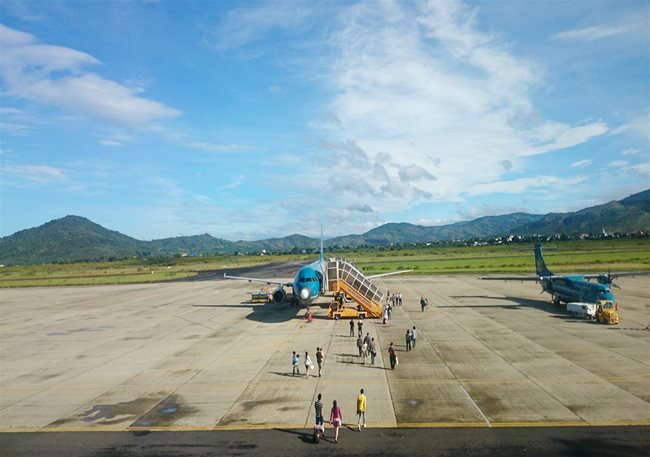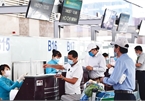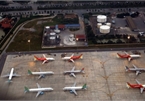 |
| Luckier than air carriers because they don’t have to incur huge losses, enterprises doing business in aviation infrastructure still saw their sales and profit plummeting in the first quarter year-on-year - PHOTO: ANH QUAN |
However, such a recovery is seen in comparison with the bottom in the first and second quarters, when Covid-19 was at its peak. A comeback to the level of sales and profit prior to the pandemic would take a much longer time.
The catastrophic coronavirus outbreak has sent almost all economic sectors into a tailspin with some in the eye of the storm being the hardest hit. One of these sectors is the civil aviation industry.
In the first quarter, international arrivals in Vietnam reached only 2.99 million, a fall of 15%, of which visitors from China, South Korea and Japan fell by 32%, 26% and 14%, respectively. These all are Vietnam’s important tourism markets due first to cultural compatibility and geographical proximity among the countries. The three markets alone account for more than a half of all international arrivals in Vietnam.
The above statistics have also faithfully mirrored business operations of Vietnam’s aviation enterprises. In concrete terms, the consolidated turnover of the national flag carrier Vietnam Airlines (HVN) was estimated at VND19.21 trillion in the first quarter, VND6.71 trillion lower than the same period last year. Notably, Vietnam Airlines suffered a loss of VND2.6 trillion in Q1 compared with a net profit of nearly VND1.98 trillion in the first quarter of last year. The temporary halt of flights caused sales of this air carrier to plummet by minus 26.3% when fixed costs, such as aircraft buying and leasing cost and maintenance fees, remained high. Although fuel cost fell dramatically, it failed to offset the diving sales and operating costs.
Vietjet Air (VCJ), another big name in Vietnam’s aviation industry, also registered a loss of VND989 billion in Q1, marking its first quarter in the red in its business history after being listed. According to Vietjet, it managed to launch a total of 29,401 flights to carry almost 4.5 million passengers. However, this figure still posts a plunge of 22% year-on-year.
To cope with difficulties posed by the Covid-19 pandemic, Vietjet said it had revised the schedule for receiving new aircraft in the first quarter, which would spare the airline from sales, transferable profit, ownership and leasing in this regard. Moreover, Vietjet was successful in negotiating with partners for extending its due payments from three to 12 months, This may help the airline save more financial resources for focusing on measures to cope with the pandemic and get ready when the market recovers.
Luckier than air carriers because they don’t have to incur huge losses, enterprises doing business in aviation infrastructure still saw their sales and profit plummeting in the first quarter year-on-year. The Airport Corporation of Vietnam (ACV) said its total sales in Q1 was about VND4.06 trillion, a fall of VND832 billion from the same period last year; and its pre-tax profit was at VND1.86 trillion, VND586 billion lower than the year-earlier period. ACV projects its total sales this year at VND11.33 trillion, a plunge of VND10.23 trillion; and its profit at VND1.48 trillion, VND9.34 trillion lower than previously planned in the year’s target.
“Old normalcy”
Despite the sharp declines across the board in the first quarter, sales and profit of aviation enterprises are projected to plunge deeper when business reports for Q2 come out. In April, almost all domestic and international flights were grounded due to social distancing measures in Vietnam.
The recovery began in late April when the measures were lifted to a certain extent. However, passengers’ prudence has limited their trips by air. Furthermore, as Vietnam has yet to open its sky to international flights, airlines’ sales will depend entirely on domestic routes.
To boost passengers’ demand, Vietnam Airlines has launched five flight routes on which cheap air fares are offered, starting from VND99,000/flight effective from May 13 to June 30. The routes include HCMC-Tuy Hoa, Haiphong-Nha Trang, Vinh-Dalat, Vinh-Buon Ma Thuot and Thanh Hoa-Buon Ma Thuot. Vietnam Airlines has cut its ticket price since 2019 to compete better with rivals, such as the newcomer Bamboo Airways. This tendency will be retained throughout this year so as to stimulate the demand for domestic flights following the pandemic.
When it comes to its fleet profile, Vietnam Airlines last year added 21 new aircraft, including 16 narrow-body A321 Neo jetliners and five wide-body A350-900 and A787-10 jetliners. All the 21 aircraft in the form of dry-leasing increased the national flag carrier’s leasing cost by VND1.7 trillion, or about VND7 billion per aircraft per month. Given the low demand for air traveling this year due to Covid-19, Vietnam Airlines may need only five additional aircraft this year, raising the size of its fleet to 108 aircraft.
The larger size of their aircraft fleet versus lower sales will inevitably pile more pressure on the profit margin of airlines across the board. However, the following compromise should be taken into account: fuel cost will be more economical because new jetliners are more fuel-efficient and the price of jet fuel in the international marketplace is still considerably cheaper.
In a bid to weather the hard times, airlines are aggressively cutting operating costs, such as payroll reduction (unpaid leave of absence from work, rotation leave, salary cuts, etc.)
In addition, aviation enterprises have implemented in one way or another more action plans to cope with Covid-19. For instance, Vietjet has expanded its services of cargo transport and launched new services and products. This airline has also given ground services for itself at Noi Bai Airport in Hanoi so that it can be more active in operations, increase additional income at this airport and improve its service quality.
Finally, the support offered by the Government in terms of taxes, fees and financial aid is expected to partly relieve the burden on aviation corporations in Vietnam. SGT
Linh Trang

More leg room needed for Vietnamese aviation
Despite potent financial support from the government, Vietnamese aviation giants are pinned to the ground by the global lockdown, signalling continuous hard rocks in the months to come.

No new airlines until aviation market recovers: VN Transport Ministry
Vietnam will temporarily halt the consideration of new airlines until the aviation market has recovered from the COVID-19 pandemic.